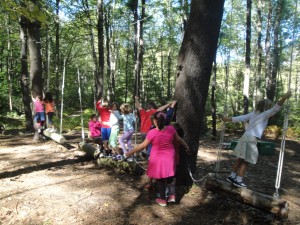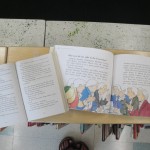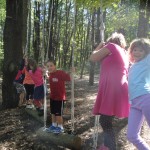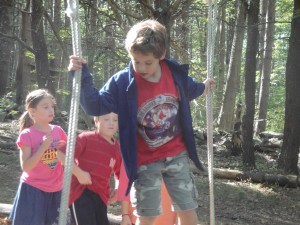 Another week has gone flying by – it has been full of reading, writing, math, cursive, a bit of science and a challenge. We always seem to be looking forward to something that doesn’t quite fit in.
Another week has gone flying by – it has been full of reading, writing, math, cursive, a bit of science and a challenge. We always seem to be looking forward to something that doesn’t quite fit in.
Working to Think of Others
Social Emotional Learning
This week we read Interrupting Chicken and talked about how challenging it is to get things done when we have to stop and start over and over again. It was funny to realize throughout the day how often and how quickly thoughts pop into our heads and then out of our mouths in the middle of something else. The class is great at knowing when someone else is interrupting and they are working to be more aware of when they are the one interrupting. Little Red Chicken will help to remind us.
We also had the opportunity to participate in the River Runner challenge with Mr. Caron. After going over safety rules, the children had to work together as a team to move twice across the swinging logs from one end to the next. The second part of the challenge was to split up into two teams that moved in opposite directions crossing in the middle to reach the other side. This required thoughtfulness, care and effort. It was so great to hear classmates offering help, providing compliments, and being willing to step back to give a friend a turn or the space needed to be successful.
Considering What We Know About Others
Learning How We are Smart – Social Emotional Learning
We are continuing to uncover the ways we are smart by thinking about what we know about each other. We read Velma Gratch and the Way Cool Butterfly. We used Velma, the main character, as a model to help us discuss what we knew about her and how we could use the actions from the story to make inferences about how she was smart.
To do this for ourselves we are considering favorite activities and how the various intelligences look in different settings. We are using what friends say, along with what we know about ourselves to create a pie graph showing how we are smart. Next week we will complete this project and work to write a paragraph or two explaining the evidence we have that helps us understand all the ways we are smart. We plan to share this with you at our fall goal setting conferences that we’ll schedule at the end of October.
The Importance of Reading Stamina
Last weekend I had the opportunity to attend the New England Reading Association’s annual conference. While there I heard Penny Kittle speak. She is the author of several professional book and works as an English teacher and Literacy Coach at Kennett High School in Conway, NH. I don’t often think about high school readers, but what she said really impacted my thinking. In third grade we are working to make sure the children read and comprehend books like Super Fudge by Judy Blume and If You Were There When they Signed the Constitution by Elizabeth Levy by the end of the school year. These goals change somewhat depending on what your child is reading now, but that is what we are working toward. To reach this benchmark, the children must be reading lots and in a wide variety of genre. We are working to help all of the children see themselves as readers of stories and information. We are working to help them love reading and that can only happen if it is enjoyable and meaningful.
 Reading can be hard work. It is often times easier to look through a book or to skim and scan rather than digging deep and working to understand. What Penny Kittle said made me even more aware of the habits I need to encourage so that thoughtful reading grows this year. She is sending her students to college or a workplace. To be successful means being able to read a lot and understand it well. The average number of pages of required reading a week for each college course is 300. That means a student taking four courses will need to read and understand 1200 pages of challenging material each week. The amount is a bit less in a workplace, but the reading there must be done at a faster pace. If students have avoided reading in high school, they are going to struggle mightily. While high school is a long way off, we can help lessen that struggle by what we do this year.
Reading can be hard work. It is often times easier to look through a book or to skim and scan rather than digging deep and working to understand. What Penny Kittle said made me even more aware of the habits I need to encourage so that thoughtful reading grows this year. She is sending her students to college or a workplace. To be successful means being able to read a lot and understand it well. The average number of pages of required reading a week for each college course is 300. That means a student taking four courses will need to read and understand 1200 pages of challenging material each week. The amount is a bit less in a workplace, but the reading there must be done at a faster pace. If students have avoided reading in high school, they are going to struggle mightily. While high school is a long way off, we can help lessen that struggle by what we do this year.
After just the first month of school we have increased our focused reading time in the classroom from 20 minutes where everyone was actually focused with a book (some were skimming, but none of the children were walking around or talking) to 35 minutes. Our goal is 45 minutes of focused reading time where children are reading both fiction or nonfiction texts that they are enjoying and understanding. When a person is reading and understanding a book that is a good fit, we typically find that the person is reading a page a minute. So when we reach our goal we can hope that third graders are reading about 225 pages a week in the classroom and 80 pages at home. That’s a great start in helping children develop the skills they’ll need for success in college and/or the workplace.
Bits and Pieces
- Thank you to all who were able to make it to the 3rd Grade Curriculum Night. We hope you found the overview helpful and enjoyed seeing your children in action here at school.
- Ask your child about the interesting details they are working to include in their narrative writing.
- Find out what is happening with Emily and Jackson in our chapter read aloud, Emily and Jackson – Hiding Out.
- Talk to your child about the NECAP practices. Please reassure them that all they need to do is to try. Some items will feel confusing, some will feel hard, others will feel easy and some will seem tricky – it is like that for everyone. We hope they will approach the testing with optimism and determination.



